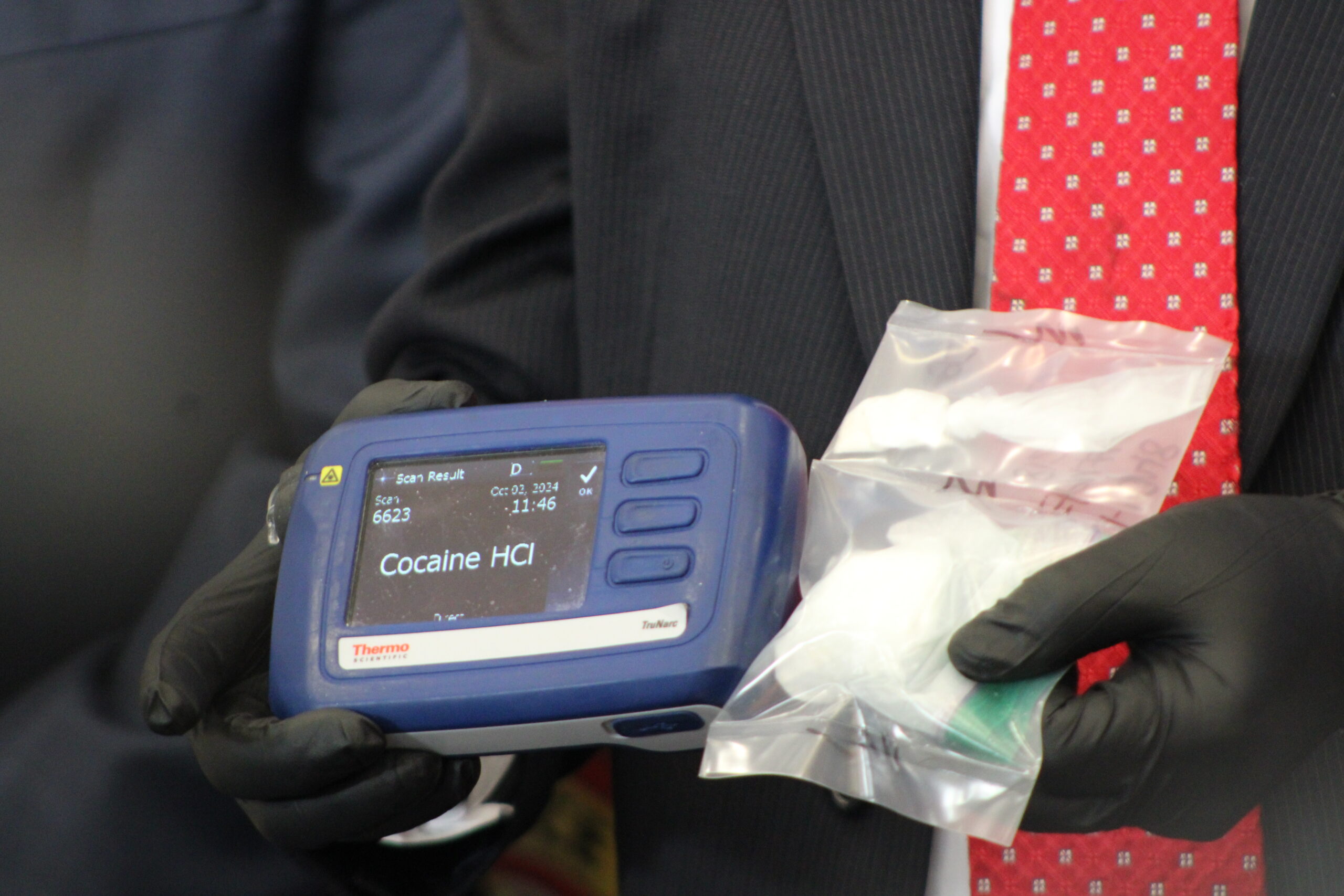Cover photo: Results of the scan (Credit – Matt Meduri)
In an effort to aid Suffolk County respond to the scourge of drugs taking the state by storm, law enforcement personnel are adding new technology to their ranks to not only preserve obtained illicit evidence, but also to enhance officer and civilian safety around toxic synthetic opioids.
Suffolk officials convened at the H. Lee Dennison Building in Hauppauge on Wednesday afternoon to showcase relatively new technology in the form of the TruNarc Handheld Narcotics Analyzer.

“This is an iPhone,” said County Executive Ed Romaine (R-Center Moriches), holding up his cell phone (pictured above). “It’s an amazing technology that has been developed. If I’m in a foreign country, I can speak into it and it can translate [the speech] into a language. Well, today, we’re here to talk about something far more significant that we can do.”
Romaine motioned to five small carrying cases with innocuous-looking electronic devices and USB sticks set up beside the podium. The TruNarc Handheld Narcotics Analyzer, described by Romaine as “an iPhone on steroids,” is able to detect 530 different controlled substances, cutting agents, and precursors.
“It can detect and warn those in law enforcement without tampering with the evidence in any manner, shape, or form,” said Romaine. “This is a huge breakthrough and protects those in law enforcement and others who might come in contact with a drug that might be fatal,” he continued, adding that these devices will make Suffolk County “a lot safer” and would serve as a “warning” to dealers.
“We have over 400 Suffolk County residents dying each year from opioid overdoses. The reason why they’re dying of opioid overdoses is overwhelmingly because of fentanyl,” said Suffolk County District Attorney Ray Tierney (R) (pictured below). “And fentanyl is a drug that looks remarkably like any other drug, but it’s really not a drug, it’s a poison.”

Tierney explained that the minutest amounts of fentanyl can be enough to kill users, first responders, and “unwitting” individuals, such as children. One such case was that of Joseph Adonis, a fourteen-month-old Holbrook child killed by a cocktail of narcotics that included fentanyl, simply because of his exposure to the drugs.
Tierney thanked the Suffolk County Police Department and the Suffolk County Police Foundation for working on the County’s access to the analyzers. The SCPD already had two TruNarc devices, but received five more, with each costing around $25,000 per unit. With seven in total, each of the SCPD’s seven precincts will receive one TruNarc device.
“I am calling on our legislature in the state to act to address the opioid overdose epidemic. But until they do, it’s good to know that here in Suffolk County we have great partners who will address this issue,” said Tierney.
The TruNarc testing device allows for non-contact testing of a substance through glass or plastic packaging, which greatly increases officers’ safety by eliminating the need to physically handle the substances.
“If you were to go to an emergency room in our department on a Friday or Saturday night, it is horrible how many drug-related overdoses we see, or worse in my scenario, from trauma. How people are driving impaired and how innocent people as well as their families are being hurt. This device that allows rapid identification at these scenes is truly a game changer,” said Dr. James Vosswinkel, Chief of Trauma, Emergency Surgery, and Surgical Critical Care at Stony Brook University Hospital. “Fentanyl is one hundred times stronger than morphine. There’s something called carfentanil, which is 10,000 times stronger, and two grams can kill fifty people. So, if these substances are out there, and they’re open and exposed, and they become airborne on contact, and if they are toxic, how much damage can be done is crazy.”
Vosswinkel added that detection and understanding of today’s drugs is paramount to patient care and that physicians shouldn’t have to question if they’re treating patients correctly if they don’t have clarity on the substance in question.

Lisa Tuozzolo (pictured above), widow of NYPD Sergeant Paul Tuozzolo, spoke in support of the partnerships that allowed for this technology to be obtained.
“On November 4, 2016, my world came crashing down,” she said as she described the circumstances of her husband’s death. While responding to a domestic violence incident where a local gang member was holding his family members at gunpoint, Sergeant Tuozzolo pursued the suspect, only to be fatally shot three times. Lisa Tuozzolo described a newfound “purpose” after the tragedy.
“I’ve been able to get back on my feet and find another purpose in life. Not only raising my boys to be two well-rounded young men, not only to carry on the memory of my husband and to make sure that he and all other line of duty officers are never forgotten, but also to find a purpose to assist the officers that are here and still with us,” said Tuozzolo. “I might not have been able to save the life of my husband, but I certainly am able to be active in the role with so many others.”
Louis Tutone, Chair of the Suffolk County Police Foundation, said that TruNarc kits would be the “first of many” of his foundation’s donations to Suffolk law enforcement.
A demonstration of the device detecting substance in real-time was then held.
Tierney described the historical method of testing substances known as the Scott Reagent test, a presumptive test kit that includes a drop of the reagent onto the drug to make a detection.
“The problem with that is when we’re talking about these extremely dangerous poisons, you’re exposing the police officer and really everybody in the room to the substance,” said Tierney. “So, now what we can do using this is we can bag it and make sure it’s safe and then use the laser technology to get the same result as the Scott Reagent without endangering people. So, for the purposes of a presumptive test, which we need to do to charge people pending the final lab result, it’s very helpful.”
By contrast, TruNarc utilizes vibrational spectroscopy, a method in which a single wavelength laser is focused on a drug sample, according to Thermo Fisher Scientific. The laser then excites the bonds of the molecules, which generates measurable scattered lights to identify the substance. Tierney describes the technique as similar to a pulse oximeter device placed on one’s finger to determine oxygen saturation in the body.
The officer conducting the demonstration held the TruNarc device to a bag of white powder. After just one or two minutes, the device came back with a result: cocaine hydrochloride.
A crucial facet of the device is its ability to store and log data, so that if law enforcement comes upon a new or previously unidentified substance, it can be scanned with the device and its results sent to laboratories for evaluation.




